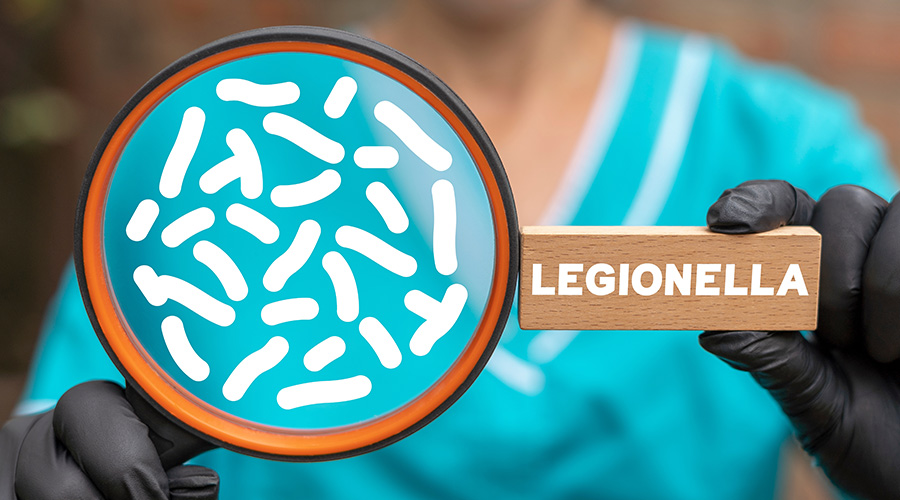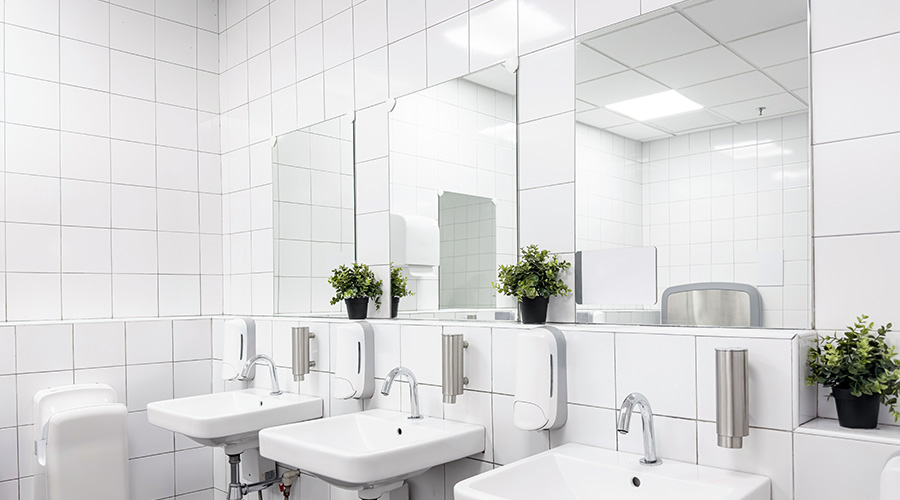Restroom Cleaning Revisited
Issues that range from facility image, user access and the bottom line are prompting managers to rethink their cleaning and product-buying strategies
Too often, managers of housekeeping operations in institutional and commercial facilities make a costly tactical error by downplaying the impact that restrooms can have on a facility’s image, as well as on an organization’s bottom line.
Facilities of all types are under growing pressure to keep these areas looking their best, despite such challenges as tightening budgets, changing fixtures, and concerns over the use of cleaning chemicals.
Restroom-cleaning Kits
Several manufacturers market restroom cleaning kits that include a cleaning cart, bucket and series of extension handles with specialized mop heads and attachments. The cart has space for storage of cleaning supplies and paper products.
Increasingly, microfiber flat mops are replacing traditional cotton string mops. Microfiber mops tend to be easier to use and lighter and can more aggressively clean the surface. Restroom cleaning kits give the cleaner easier access to all necessary products and tools while cleaning.
Some advocates of microfiber cleaning cloths assert that these cloths eliminate or mitigate the need for cleaning chemicals. But the application of appropriate chemicals during the cleaning process can enhance the effective cleaning of restrooms.
Power-assisted Cleaning Equipment
For several years now, manufacturers have offered specialized power washers for cleaning restrooms. Generally, a power washer is cart-mounted — the cart can carry limited cleaning supplies — and come in various shapes and sizes.
The machine basically power washes the restroom from ceiling to floor — after the floor has been swept — and air-dries the room before use. These units have specialized chemicals applied through a solution pick-up hose that delivers deep cleaning and surface drying without spots, much like an effective dishwashing agent. More advanced units can power-spray the room, as well as pick up the residue solution after cleaning so the restroom is not out of service too long.
When using these units, operators need to use all safety precautions and protect all paper goods from solution overspray. When used correctly, these units really deep-clean restrooms.
Steam or Vapor Cleaning
This type of cleaning is growing in popularity. The system does not use chemicals but instead uses a tank that superheats water. It applies steam to the dirty areas through a special wand and an applicator to which the operator can attach cleaning towels. The operator wipes all surfaces with the superheated vapor, changing the cloth as it becomes soiled.
The units also have special heads for crevice cleaning. Besides using these units for cleaning restrooms, crews also can use them cleaning kitchens because steam easily breaks down grease. The units also can be effective for cleaning walls when operators use the wand and towel attachment.
Some manufacturers state that no chemicals are necessary with this type of product, but managers should familiarize themselves with the claims and the infection-control needs of their facilities. Also, operators need to be sure to wear appropriate safety gear because the wand handles can become hot.
Going Touchless
Providing equipment — no matter how innovative it might be — will not necessarily solve all restroom-cleaning problems. Restrooms often feature multiple surfaces, including many that users must touch, such as doorknobs, door plates, faucets, soap dispensers, seats, flush valves and towel dispensers. And touching these surfaces creates a need for cleaning.
Using touchless restroom products and systems can minimize the need to clean surfaces, and it can make the department more efficient by giving cleaners more time to clean other surfaces that are more visible such as the sinks, toilet bowls and floors.
By planning prior to the construction or during renovation, managers can integrate the numerous types of touchless restroom technology available today, including these:
- self-flushing toilets and urinals
- auto-on and auto-off faucets
- auto-on and auto-off soap dispensers
- auto-on and auto-off hand dryers
- automatic paper towel dispenser
- entryways with no fixed entrance doors that instead use a maze entry pattern to ensure privacy
- toilet seat covers activated by the touch of a button
Two additional products are becoming increasingly popular in restrooms — waterless urinals that have no plumbing or pipes to cleaning and waterless hand cleaners and sanitizers, which minimize the need for paper towels, soap dispensers and even sinks.
Finally, some restroom systems now combine a hand dryer, a water-dispensing source and a soap dispenser. Users activate the unit by placing their hands into a sink recessed into a wall — note that there is no need for sink counters. The unit dispenses soap and water, and after the user removes their hands while a built-in hand dryer dries them.
Design also affects a restroom’s cleaning demands. Users of modern touchless restrooms enter through a doorless entryway — a maze— use a toilet or urinal that flushes itself, then walk over to a sink with a faucet that turns on and off automatically. They would proceed to the hand dryer or automatic towel dispenser that would activate immediately. Users could leave the facility without touching any fixture or surface.
By using touchless technology, the manager has immediately addressed two concerns of restroom users: the touching of fixtures and the fears of infection. The manager also has made the restroom easier to clean by using such state-of-the-art technology.
By combining advanced cleaning systems with touchless and other innovative technologies — such as waterless urinals and hand cleaners — managers can increase the level of cleanliness in restrooms while controlling costs through greater productivity. The end result is cleaner restrooms that are cleaned more cost effectively while generating fewer customer complaints.
The Image of Restrooms
In 2002, a flurry of data and polls shed new light on the problem of restroom cleanliness and the impact unclean restrooms can have on workers, hotel guests and students.
According to a survey by the Opinion Research Corp. on school restroom cleanliness, “the problem is so severe that close to 20 percent of the middle and high school students admitted to their parents that they avoid the school restrooms due to dirty and unsafe conditions.”
The impact is even more dramatic in the nation’s hotels. According to a recent poll of 618 adults, 84 percent of respondents inspected the bathroom and supplies such as toilet paper and facial issues within 15 minutes of entering a hotel room, and 55 percent examined the bathroom immediately after entering a room.
Regardless of facility type, however, restroom cleanliness or its lack — can have huge implications.
The impact can’t be understated. Consider this example: An institution of higher learning had received an award for having the best restrooms in the United States. In response, people wrote letters, newspaper and television reporters showed up on the doorsteps of the institution, and the award’s announcement even made national news.
The point is that people recognize and appreciate clean restrooms. Indeed, some visitors touring the university campus after the award announcement specifically requested to see the award-winning restrooms.
The importance of the cleanliness of restrooms is critical to both managers and the customers that use their facilities. Maintaining restrooms at the highest state of readiness at the lowest feasible cost is an imperative, since according to survey results, the leading source of complaints in facilities continues to be restroom cleanliness, followed closely behind by concerns about restroom supplies. Customers expect housekeeping managers to keep restrooms clean. Yet many facilities continue to fail in these efforts.
To help managers and their staffs refine restroom cleaning, today’s equipment offers a range of products as alternatives to traditional mops, buckets and wringers. Some new systems are incredibly simple, while others are more complex. But most systems enhance the performance of cleaning chemicals — if any chemicals are used at all — and all enable managers to minimize complaints from restroom patrons.
— Alan S. Bigger
and Linda B. Bigger
|
Related Topics:











